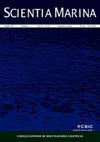Ostreopsis cf. ovata and Ostreopsis lenticularis (Dinophyceae: Gonyaulacales) in the Galapagos Marine Reserve
IF 0.9
4区 生物学
Q4 MARINE & FRESHWATER BIOLOGY
引用次数: 3
Abstract
The genus of benthic dinoflagellates Ostreopsis is of particular interest because some species negatively impact human health and coastal marine ecosystems. Ostreopsis populations from a remote area, such as the Galapagos Marine Reserve with its unique biodiversity, can provide significant data. Samples of epibionthic dinoflagellates were collected from two islands (Santa Cruz and Santa Fe) in 2017. Species of the genera Gambierdiscus, Amphidinium, Coolia and Ostreopsis were found. Ostreopsis strains were isolated to characterize their morphology, molecular biology and toxicity. Three different morphotypes of Ostreopsis based on dorsoventral and width diameters (n=369) were distinguished. The small cell morphotype was dominant in ten samples, with abundances of up to 33405 cells g-1 fresh weight of macroalgae. A total of 16 strains were isolated from field samples with subsequent polymerase chain reaction amplifications of rDNA, 5.8S rDNA and internal transcribed space regions; 13 strains (small cell morphotype) clustered in the O. cf. ovata Atlantic/Indian/Pacific clade; and 3 strains (large cell morphotype) clustered in the Ostreopsis lenticularis genotype from the type locality. The strains proved to be non-toxic. The presence of these genera/species represents a potential threat to marine ecosystems, and it is thus important to consider benthic species in the surveillance of harmful algae blooms in the reserve.加拉帕戈斯群岛海洋保护区的卵形和透镜状角链opsis(恐龙科:Gonyaulacales)
底栖甲藻Osteopsis属尤其令人感兴趣,因为一些物种对人类健康和沿海海洋生态系统产生了负面影响。来自偏远地区的Osteopsis种群,如具有独特生物多样性的加拉帕戈斯海洋保护区,可以提供重要数据。2017年,从两个岛屿(圣克鲁斯和圣达菲)采集了表生甲藻样本。发现了甘比尔铁饼属、安菲藻属、库利亚属和Osteopsis属的物种。从中分离得到Osteopsis菌株,对其形态、分子生物学和毒性进行了表征。根据背中央和宽度直径,区分了三种不同的Osteopsis形态类型(n=369)。小细胞形态型在10个样品中占主导地位,丰度高达33405个细胞-1新鲜重的大型藻类。共从现场样品中分离出16株菌株,随后进行rDNA、5.8S rDNA和内部转录空间区的聚合酶链式反应扩增;13个菌株(小细胞形态型)聚集在O.cf.ovata大西洋/印度/太平洋分支中;和3个菌株(大细胞形态型)从模式位置聚集在慢角Osteopsis基因型中。这些菌株被证明是无毒的。这些属/种的存在对海洋生态系统构成了潜在威胁,因此,在监测保护区有害藻类水华时,考虑底栖物种很重要。
本文章由计算机程序翻译,如有差异,请以英文原文为准。
求助全文
约1分钟内获得全文
求助全文
来源期刊

Scientia Marina
生物-海洋与淡水生物学
CiteScore
2.10
自引率
0.00%
发文量
21
审稿时长
6-12 weeks
期刊介绍:
Scientia Marina is the successor to Investigación Pesquera, a journal of marine sciences published since 1955 by the Institut de Ciències del Mar de Barcelona (CSIC). Scientia Marina is included in the Science Citation Index since 1998 and publishes original papers, reviews and comments concerning research in the following fields: Marine Biology and Ecology, Fisheries and Fisheries Ecology, Systematics, Faunistics and Marine Biogeography, Physical Oceanography, Chemical Oceanography, and Marine Geology. Emphasis is placed on articles of an interdisciplinary nature and of general interest.
 求助内容:
求助内容: 应助结果提醒方式:
应助结果提醒方式:


